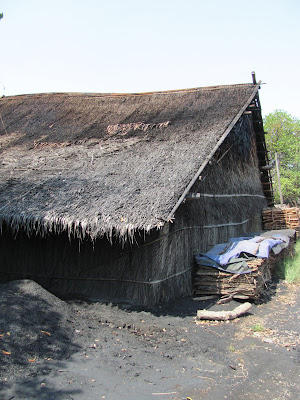
On the final day of our conference in Bangkok they organized a choice of two study tours. The first visited a center where they practice traditional Thai medicine. Participants on this trip received a traditional Thai massage. Sounds pretty good doesn't it. Of course, bio-nerds like me are easily distracted, so rather than going to get a Thai massage I went along on the trip that examined "Local efforts to preserve natural resources and the environment". This trip took us to coastal Thailand to observe the mangrove habitat and help plant mangrove seedlings.
It turns out there were plenty of other bio-nerds ready to see the mangroves so we had to load up on a big bus.

After about an hour and a half drive we arrive at the coastal village of Klong Khone. Obviously, marine products are the main source of income in a coastal town like Klong Khone. More dried seafood (don't see too much of this in Lubbock).

This (out of focus) photo shows one of the main products raised in the coastal estuaries and bays- cockles (a type of mussel).

Most of the houses were built along the river on stilts.

A forestry professor from one of the Thai universities told us a little bit about the mangroves.

The Head Man from Klong Khone told us about attempts to add tourism as another source of income for the village.

While we were waiting to be able to board the boats that would take us through the mangroves I wandered down the street a bit. Here is a family heading home from the local store. It is possible to put at least six people on one of those scooters.

Team Malaysia is ready to safely ride down the river.

Heading down the river we passed more houses on slilts.

The boat.

Headed down the river.

Entering into the bay.

Once we got into the mangroves we saw the long-tailed macaques again. This time they fed them bananas. Because the water was shallow most of the monkeys got the food by wading. Maybe because she was weighed down by her baby this female was having trouble getting any food so she decided to go for a swim. While she was swimming the baby was completely submerged underwater.

If you have ever wandered what a soaked baby monkey looks like then just take a look.

Restoring the Mangroves
Over 20 - 30 years ago people removed about 90% of the mangroves in this area to set up shrimp farms. In 1988 a disease outbreak basically whiped out shrimp farming. Because the mangroves were already damaged people were not able to return to their traditional ways of making a living because the animals they depended on needed the mangroves. Recently, there have been efforts to restore the mangroves. We were able to help with the restoration. As you will see- it is a dirty job, but someone has to do it.

Each boat carried some mangrove seedlings for us to plant.

Because mangrove seedlings establish in the intertidal region, we had to get muddy. TUSEF provided each of us with a pair of black knee socks to try to make the clean up a little easier. Quite a fashion statement!

Working in the mangroves provided sort of a Catch 22. It was difficult to move in the thick mud, but if you stayed too long in one place then you sank deeper and deeper into the muck. We all persevered to make sure that our babies were safely planted.

Post-planting clean up took a while.

Here are the seedlings we planted. Hopefully, this will add to the nearly 10,000 acres of mangroves that have been restored.

Luch Time
We had lunch at a Krateng (an offshore shelter used by local fishermen and cockle farmers). Today kratengs are also used by tourists.

They prepared a great spread for us...

so everyone was happy to dig in.

Looking out from the Krateng towards the sea.

Visit to a Charcoal Factory
On the way to the charcoal factory we passed by some of the remaining shrimp farms.

People have starting planting mangrove plantations to make charcoal.

The main shed at the charcoal factory.

Mangrove wood makes especially good charcoal.

A "no smoking" sign seems a little out of place at a charcoal factory.

The manager of the factory explained how charcoal was made.

The mangrove wood is carried to the factory in small boats.

Almost everyone was interested in what the manager had to say...

but I have to admit that I was distracted by the mudskippers.

There were a number of kilns inside of the charcoal shed.

The final product. From wood to charcoal takes about 45 days.

Bagged up and shipped off for sale.


No comments:
Post a Comment